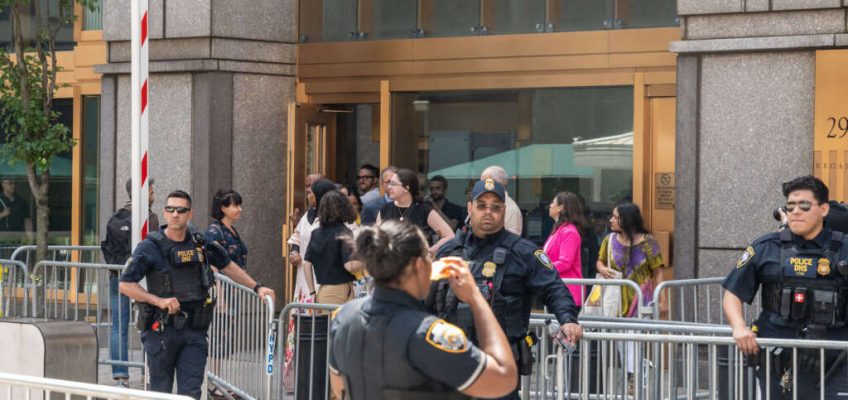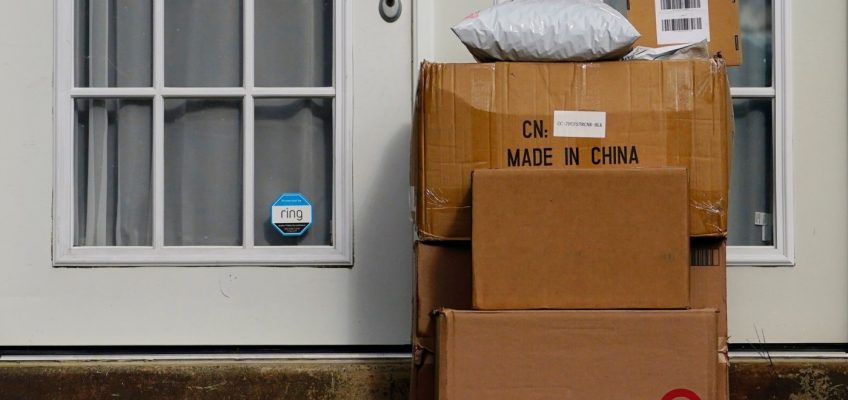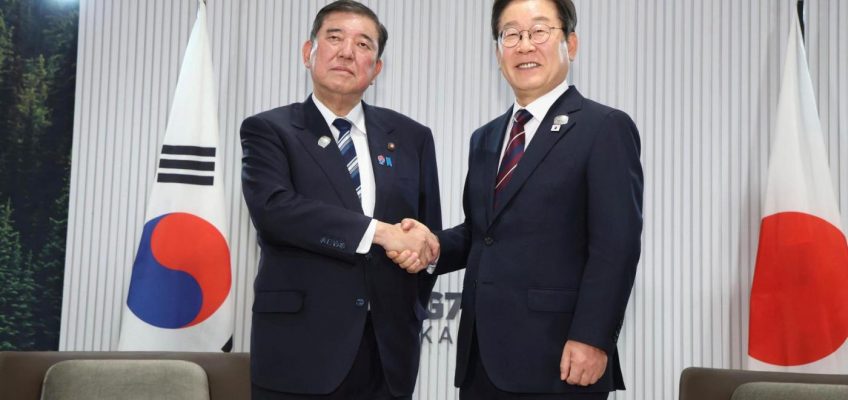A district court judge ordered that immigrants held for processing receive access to phone calls, more space and bedding mats, among other things. The Department of Homeland Security, which oversees U.S. Immigration and Customs Enforcement, refuted the claims and says it will appeal the order.
Immigration officers outside 26 Federal Plaza in June. (Ayman Siam/Office of NYC Comptroller)
A federal judge in Manhattan issued a temporary restraining order requiring U.S. Immigration and Customs Enforcement (ICE) to improve conditions in the processing area on the 10th floor of 26 Federal Plaza, where dozens of immigrants are being detained.
This order follows a class action lawsuit filed by the American Civil Liberties Union (ACLU), the New York Civil Liberties Union (NYCLU), Make the Road New York, and Wang Hecker LLP, which painted a bleak picture of conditions inside the facility.
The order requires ICE to align with its own standards for detention sites, which include providing at least 50 square feet of personal space and bedding mats for each person sleeping there, as well as access to hygiene products and medications.
Additionally, the order requires those being held have access to free and confidential calls with attorneys within 24 hours of detention, plus access to interpreters if needed.
“[Detained migrants] also don’t have an opportunity to talk with immigration attorneys, because we’ve all tried, and [ICE] doesn’t facilitate calls for people who are detained at 26 Federal Plaza, no matter how long they are detained there,” said Karla Marie Ostolaza, managing director for the immigration practice in the The Bronx Defenders.
Advocates celebrated the decision after videos and media articles revealed conditions inside the facility, which the New York Immigration Coalition called “crowded and unsanitary,” with some people held for days or weeks without access to showers, bedding, change of clothes and other necessities.
Since late spring, ICE has been targeting migrants who show up to court for routine immigration hearings, part of the Trump administration’s efforts to ramp up deportations across the country.
“The Constitution requires that no one—especially someone unlawfully arrested at their immigration hearing, which happened to so many people in this case—should have to endure the dehumanizing conditions we’ve challenged in 26 Federal Plaza,” said Bobby Hodgson, assistant legal director at the NYCLU.
However, the Department of Homeland Security, which oversees ICE, denied the claims and said it will appeal the order. “This order and this lawsuit are driven by complete fiction about 26 Federal Plaza,” DHS Assistant Secretary Tricia McLaughlin said via email.
“Any claim of subprime conditions at ICE facilities are categorically false. 26 Federal Plaza operates as a processing center, brief intake for illegal aliens, and then transfer to an ICE detention center meeting national standards for care and custody, which are in most cases better than facilities which detain Americans,” she added.
District Court Judge Lewis Kaplan ordered that everyone detained at the site receive a printed “notice of rights” within one hour of arrival, and have access to licensed medical care between 7 a.m. and 9:30 p.m. The order will remain in effect for 14 days.
The judge’s order also says that ICE’s Detainee Locator System, a way for loved ones to find the location of an ICE detainee online, must identify people’s locations in real time or as close to it as possible.
“ICE has repeatedly lied and skirted accountability about what is happening on the 10th floor, as people are being detained for days or weeks at a time without basic care,” said Murad Awawdeh, president and CEO of the New York Immigration Coalition.
Activists and faith leaders held a civil disobedience protest outside 26 Federal Plaza on Friday, August. 8, 2025. (Photo courtesy of Climate Defenders)
ICE ordered to work with NY orgs
Individuals detained at 26 Federal Plaza are typically recent arrestees by ICE and are awaiting transfer to other, more permanent detention centers.
In cases where the detainee entered the country and overstayed their visa, they would normally be eligible for bail or released under specific conditions.
However, this was not happening at the New York Field Office at 26 Federal Plaza in recent years, as described in the case of Velesaca v. Decker, a separate 2020 lawsuit that alleges the vast majority of detainees were not given individualized assessments and that ICE essentially operated a “no-release” policy.
“My initial determination that a No-Release Policy likely existed was based on data indicating that in the period from June 2017 to September 2019, less than 2 [percent] of cases resulted in release and less than 0.1 [percent] had a bond set,” explains a recent court motion in the case.
After years of legal battles, in 2022, a judge announced a settlement in which ICE agreed that “it is required to provide individualized initial custody determinations to covered noncitizens.”
However, as things seemed to remain unchanged, the New York Civil Liberties Union and the Bronx Defenders—who had been at the forefront of the case since the beginning—filed a motion in March of this year asking the court to enforce the 2022 settlement.
On Aug. 7, a federal judge in the Southern District of New York ordered ICE to comply, meaning the New York Field Office must conduct assessments to determine whether to release or detain migrants.
According to Judge Alvin Hellerstein’s order, from March 2022 (when the settlement order was issued) to February 2025, only 0.8 percent of cases resulted in someone’s release, and only 0.4 percent had a bond set. Moreover, the judge’s decision requires ICE and the New York organizations that filed the suit to meet to develop a “compliance plan.”
“What compliance looks like isn’t clear,” said Anne Venhuizen, supervising attorney at The Bronx Defenders. The custody determination, explained Venhuizen, “is required to happen within 48 hours, unless, for some reason, there’s an exigent circumstance.”
ICE didn’t immediately respond to a request for comment on the ruling.
“It makes me very hopeful for finding a better way to enforce people’s right to have an initial custody determination that is meaningful, that really takes into account people’s individual situations and whether they should be released or not, instead of every single person that goes through 26 Federal Plaza getting a rubber stamp, like you are not eligible,” Ostolaza said.
To reach the reporter behind this story, contact Daniel@citylimits.org. To reach the editor, contact Jeanmarie@citylimits.org
Want to republish this story? Find City Limits’ reprint policy here.
The post ICE Ordered to Improve ‘Dehumanizing Conditions’ for Migrants Held at 26 Federal Plaza appeared first on City Limits.




